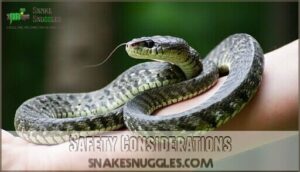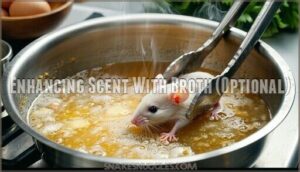This site is supported by our readers. We may earn a commission, at no cost to you, if you purchase through links.

You’ll thaw frozen mice in the refrigerator overnight, then warm them in hot water until they reach body temperature.
Use feeding tongs to offer the mouse headfirst, mimicking natural hunting behavior.
Most adult snakes eat every 1-2 weeks, while juveniles need weekly meals.
The mouse should be roughly as wide as your snake’s thickest part.
Never handle your snake for 48 hours after feeding to prevent regurgitation.
Getting the timing, temperature, and technique right makes all the difference in your snake’s health and happiness.
Table Of Contents
- Key Takeaways
- How to Feed a Snake Mice?
- Understanding Snakes’ Dietary Requirements
- Choosing The Right Prey: Frozen Vs. Live
- Thawing Frozen Rodents Safely
- Warming The Mouse for Digestion
- Enhancing Scent With Broth (Optional)
- Offering The Mouse to The Snake Safely
- Feeding Frequency for Pet Snakes
- What to Do if Your Snake Rejects Food
- Avoiding Overfeeding and Health Issues
- Tips for Successful Feeding of Your Pet Snake
- Frequently Asked Questions (FAQs)
- How do I feed my snake a mouse?
- How often do you feed mice to snakes?
- Is it better to feed a snake dead or alive mice?
- Do snakes eat mice?
- How do you get a snake to eat a frozen mouse?
- Can you feed a mouse to a snake?
- How often should you feed a snake a mouse?
- How often should you feed a snake mice?
- Can I feed wild mice to my snake?
- Why can’t i feed my snake live mice?
- Conclusion
Key Takeaways
- You’ll keep your snake safer by choosing frozen mice over live prey, which eliminates bite risks, injuries, and disease transmission while providing the same nutritional value.
- You should thaw frozen mice overnight in the refrigerator, then warm them in hot water to body temperature (98-100°F) before feeding to ensure proper digestion.
- You’ll need feeding tongs to safely present the mouse headfirst to your snake, mimicking natural hunting behavior while keeping your hands away from the strike zone.
- You should feed adult snakes every 1-2 weeks and juveniles weekly, avoiding handling your snake for 48 hours after feeding to prevent regurgitation.
How to Feed a Snake Mice?
Feeding your snake mice properly guarantees their health and your safety.
You’ll need to decide between frozen and live options – the Live Feeding Debate centers on safety versus natural behavior.
Frozen mice are safer and more convenient for most snake feeding situations.
Start by thawing frozen prey in cold water or your refrigerator.
Warm it to body temperature using warm water.
Use feeding tongs to offer the mouse, holding it by the tail near your snake’s head.
This stimulates their hunting instinct safely.
Create a calm environment during feeding frozen mice sessions.
Proper snake diet management prevents stress and guarantees successful meals every time.
Understanding Snakes’ Dietary Requirements
After you’ve decided to feed your snake mice, understanding their dietary requirements becomes your next priority.
Different snake species have unique nutritional needs that affect their health and longevity.
Your snake’s digestive health depends on matching the right food to their natural diet.
Most pet snakes thrive on rodents, but some species need prey variety like birds or amphibians.
The size, age, and activity level of your snake determines their feeding schedule.
Here’s what affects your snake’s snake nutrition:
- Species-specific needs – Ball pythons differ from corn snakes
- Age and size – Juveniles need smaller, more frequent meals
- Seasonal changes – Some snakes eat less in winter
- Health status – Sick snakes may refuse food
- Environmental factors – Temperature affects appetite
Understanding these snake dietary needs helps you create the perfect snake diet plan.
Choosing The Right Prey: Frozen Vs. Live
You’ll face an important choice when feeding your snake: frozen or live mice. Each option has different benefits for safety, nutrition, and convenience that affect both you and your pet.
Safety Considerations
Your snake’s safety depends on smart choices between frozen and live prey.
Your snake’s wellbeing starts with making the right feeding choices from day one.
Live rodents can bite or scratch your snake, causing infections or injuries. Frozen options eliminate these risks while reducing zoonotic diseases transmission through proper hygiene protocols.
Many owners find it convenient to source pre-killed prey online.
| Safety Factor | Frozen Prey | Live Prey |
|---|---|---|
| Injury Risk | None | High – bites/scratches |
| Disease Control | Better hygiene | Higher contamination |
| Storage Safety | Controlled temperatures | Immediate feeding needed |
| Handling Risks | Minimal with tongs | Potential escape/bites |
Nutritional Value Comparison
Beyond safety factors, you’ll want to understand how frozen mice for snakes stack up nutritionally against live prey. Both options meet your snake’s nutritional needs effectively.
| Aspect | Frozen Mice | Live Mice |
|---|---|---|
| Nutrient Density | Consistent levels | Variable based on diet |
| Rodent Vitamins | Preserved when stored properly | Fresh but depends on prey gut-loading |
| Wild Diet Simulation** | Adequate for captive snakes | Closer to natural hunting |
Digestion efficiency remains similar regardless of your choice in reptile food. Live rodents, however, present a higher risk of parasites.
Convenience and Storage
Frozen mice win the storage game hands down.
You can buy in bulk and stack them neatly in your freezer for months.
No last-minute pet store runs or dealing with live rodent cages.
Here’s how frozen and live options compare for convenience:
| Storage Aspect | Frozen Mice | Live Mice |
|---|---|---|
| Shelf Life | 6+ months in freezer | Must feed within days |
| Space Needed | Compact freezer storage | Large cage setup required |
| Maintenance | Zero daily care | Daily feeding and cleaning |
| Availability | Always ready when thawed | May escape or die unexpectedly |
| Bulk Purchasing | Cost-effective large orders | Limited by cage capacity |
Proper freezer organization and rodent handling make frozen prey the clear winner for busy snake owners.
Thawing Frozen Rodents Safely
Once you’ve chosen frozen rodents, proper thawing becomes your next priority. Think of it like defrosting dinner – patience pays off.
Remove the mouse from its original packaging and place it in a clean plastic bag.
You have two reliable options for safe thawing practices:
- Refrigerator method: Leave overnight for 12-24 hours (slow but safest)
- Cold water method: Submerge bagged mouse for 30-60 minutes (faster option)
- Never use microwaves – they create hot spots that can harm your snake
- Avoid boiling water – this partially cooks the prey
- Check storage dates – discard rodents frozen over six months
Thawing time impact directly affects your snake’s digestion. Temperature monitoring guarantees the mouse reaches room temperature evenly.
Remember, refreezing risks contamination, so use thawed mice immediately.
Watch for convenient thawing products designed to streamline the process.
Watch for rodent spoilage signs like off odors before feeding.
Warming The Mouse for Digestion
Once your frozen mice have finished thawing, you’ll need to warm them properly for snake digestion.
Perfect timing is everything – your snake’s digestive system depends on properly warmed prey to function efficiently.
Cold prey slows down your snake’s digestive system and can cause health problems.
The ideal temperature for warming mouse prey is 98-100°F, which mimics live prey body heat.
You have several warming methods to choose from.
Heat lamps work well but require careful monitoring. Heating pads offer controlled temperature increases. The most reliable approach involves placing your thawed mouse in warm water for 15-20 minutes.
| Warming Method | Temperature Range | Time Required |
|---|---|---|
| Heat Lamp | 98-100°F | 10-15 minutes |
| Heating Pad | 95-100°F | 15-20 minutes |
| Warm Water | 98-102°F | 15-20 minutes |
| Room Temperature | 70-75°F | 30-45 minutes |
Proper warming improves digestion efficiency and appeals to picky eaters who prefer body-temperature prey.
Using frozen prey offers the benefit of eliminating risk of injury compared to live feeding.
Enhancing Scent With Broth (Optional)
After warming your frozen rodents, you can take an extra step to make them irresistible to picky eaters. Scent enhancement through broth dipping transforms ordinary thawed mice into aromatic meals that trigger your snake’s natural hunting instincts.
Broth Types matter when selecting your enhancement liquid. Chicken, beef, or fish broth work well, but choose low-sodium varieties to avoid health issues. Some keepers prefer fish-based broths for their stronger scent profiles.
Here’s your simple enhancement process:
- Warm low-sodium broth to room temperature
- Dip the thawed mouse for 10-15 seconds
- Allow excess broth to drain off completely
- Present the enhanced prey immediately to your snake
Dipping Frequency should remain occasional – maybe once every few feedings. Overuse can create dependency where your snake won’t accept unenhanced prey. Scent Alternatives include rubbing prey with familiar foods or using commercial scent enhancers designed for snake feeding. This technique particularly helps during Nutritional Impact periods when snakes need encouragement to maintain healthy eating habits.
Offering The Mouse to The Snake Safely
Once your mouse is properly warmed, you’ll need to present it safely to your snake. Always use feeding tongs or forceps instead of your hands – this keeps your fingers far from the strike zone and prevents your snake from associating you with food.
Hold the prekilled prey by its head or tail, positioning it near your snake’s head to trigger its natural hunting instincts. Gently wiggle the mouse to mimic movement, which often encourages reluctant feeders to strike.
Keep the motion subtle but noticeable. If your snake seems uninterested, try gently tapping its nose with the mouse to stimulate feeding behavior. Using proper feeding equipment is essential for safe handling.
Consider using a separate feeding enclosure to prevent substrate ingestion and create a dedicated feeding routine. This handling technique also reduces territorial behavior in your snake’s main habitat, making future maintenance safer and less stressful for both of you.
Feeding Frequency for Pet Snakes
Once you’ve safely offered your mouse, determining the right feeding frequency becomes your next priority. Your snake’s feeding schedule depends on several key factors that you’ll need to balance carefully.
Snake age plays the biggest role in feeding frequency. Baby snakes under two years need meals every 4-7 days to support their rapid growth. Adult snakes can wait 1-2 weeks between feedings as their metabolism slows down.
Species needs vary substantially. Ball pythons typically eat every 7-10 days, while corn snakes follow a 5-7 day schedule when young. Your snake’s activity level also affects how often they’ll need food – more active species burn energy faster.
Environmental factors like temperature directly impact snake metabolism. Cooler conditions slow digestion, while proper heating encourages regular feeding patterns.
Here’s what affects your snake feeding schedule:
- Individual variation – some snakes naturally eat more or less frequently
- Seasonal changes – breeding season may impact appetite
- Health status – sick snakes often refuse food temporarily.
Monitor your snake’s body condition and adjust accordingly.
What to Do if Your Snake Rejects Food
Why won’t your snake eat? Don’t worry—food rejection happens to even experienced keepers. Your reluctant eater might be dealing with underlying illnesses that affect appetite, so watch for other symptoms like lethargy or unusual behavior.
Check for enclosure stressors first. Temperature drops, excessive noise, or improper humidity can trigger snake feeding challenges. During the shedding cycle, most snakes naturally refuse food, so patience is key.
Try offering prey variety—different sizes or types might spark interest. Some snakes get picky about their usual menu. Scenting frozen mice with chicken broth often works wonders for finicky feeders.
If snake feeding issues persist beyond two weeks, schedule a veterinary consultation. Professional snake feeding solutions can identify health problems early. Document feeding patterns to help your vet diagnose the issue effectively.
Avoiding Overfeeding and Health Issues
Even snakes that rejected food yesterday can become victims of overfeeding tomorrow. You’d be surprised how quickly a snake’s appetite can swing from picky to greedy.
Obesity risks in captive snakes mirror those in other pets – excess weight strains organs and shortens lifespans.
Watch for these warning signs that indicate you’re crossing the line:
- Your snake develops visible fat rolls along its body
- Regurgitation causes become frequent after meals
- Food rejection periods alternate with overeating episodes
- Your pet shows reduced mobility or difficulty moving
- The snake’s body loses its natural muscle definition
Proper portion control prevents impaction prevention issues and organ damage. Maintaining dietary variety while monitoring feeding frequency keeps your snake healthy.
Remember, wild snakes often go weeks between meals – your pet doesn’t need daily buffets.
Tips for Successful Feeding of Your Pet Snake
Master these snake feeding tips to transform mealtime from stressful to seamless. Create a consistent feeding schedule that matches your snake’s natural rhythm.
Your enclosure setup should include proper temperatures and water availability to support digestion. When handling picky eaters, patience beats pressure every time.
Monitor snake health by watching feeding responses and body condition.
Essential tools for feeding snakes and thawing frozen rodents safely:
- Long-handled feeding tongs for safe prey presentation
- Separate feeding container to prevent substrate ingestion
- Digital scale to verify proper prey size
- Temperature gun to check rodent warmth before offering
Frequently Asked Questions (FAQs)
How do I feed my snake a mouse?
Thaw frozen mice overnight in your fridge, then warm them in hot water for 10-15 minutes.
Use feeding tongs to dangle the mouse near your snake’s head, wiggling slightly to trigger their strike response.
How often do you feed mice to snakes?
Feeding frequency isn’t rocket science, but timing matters tremendously.
You’ll typically feed adult snakes every 1-2 weeks, while juveniles need meals every 5-7 days.
Adjust based on your snake’s age and species.
Is it better to feed a snake dead or alive mice?
Dead mice are safer for your snake and easier for you.
Pre-killed frozen prey eliminates bite risks, parasites, and stress while providing consistent nutrition.
You’ll avoid potential injuries and ethical concerns with this preferred feeding method.
Do snakes eat mice?
Ironically, these slithering "vegetarians" are actually carnivorous hunters.
Yes, you’ll find snakes absolutely do eat mice—they’re a staple food source.
Most pet snakes thrive on appropriately-sized frozen-thawed mice fed regularly.
How do you get a snake to eat a frozen mouse?
You’ll need to thaw the frozen mouse completely in cold water.
Then warm it in hot water until it reaches body temperature.
Use feeding tongs to present it safely to your snake.
Can you feed a mouse to a snake?
You can feed mice to snakes – it’s their bread and butter.
Use pre-killed frozen mice that you’ve properly thawed and warmed.
This method’s safer than live feeding and prevents injuries to your snake, using pre-killed frozen mice is the preferred approach.
How often should you feed a snake a mouse?
Adult snakes typically eat every 1-2 weeks, while juveniles need feeding every 5-7 days.
Your snake’s age, size, and species determine the exact schedule.
Monitor their body condition and adjust frequency accordingly.
How often should you feed a snake mice?
Unlike daily dog meals, snakes eat infrequently.
You’ll feed juveniles weekly, while adults eat every 10-14 days.
Monitor your snake’s body condition and adjust timing based on age, size, and species requirements for ideal health.
Can I feed wild mice to my snake?
You shouldn’t feed wild mice to your snake.
Wild rodents carry parasites, diseases, and harmful bacteria that can make your pet seriously ill.
Stick with frozen-thawed or captive-bred feeder mice for safety.
Why can’t i feed my snake live mice?
Live mice pose serious risks to your snake’s safety.
They can bite, scratch, or injure your pet during feeding.
Pre-killed frozen mice eliminate these dangers while providing the same nutritional value.
Conclusion
Watching your snake successfully strike and consume its meal brings immense satisfaction to any reptile keeper.
Mastering how to feed a snake mice requires patience, proper technique, and consistent practice.
You’ve learned the essential steps from thawing frozen prey to timing feedings correctly.
Remember to use feeding tongs, maintain proper temperatures, and respect your snake’s post-meal rest period.
With these expert tips, you’ll confidently provide nutritious meals that keep your serpent healthy and thriving for years ahead, using techniques that require consistent practice.
- https://abdragons.com/blog/frozen-mice-and-rats-for-snake-feeding/
- https://www.thesprucepets.com/feeding-snakes-frozen-mice-1239476
- https://www.reddit.com/r/snakes/comments/7lkhcc/my_fool_proof_method_of_switching_from_live_to/
- https://www.quora.com/What-are-some-humane-ways-to-feed-mice-to-a-snake
- https://talis-us.com/pt-br/blogs/news/10-tips-for-snake-feeding-a-comprehensive-guide?srsltid=AfmBOorossDaFCk7hGQHRuFMB7UigCmAVbObqE5EN039Oo715sfB365c

















